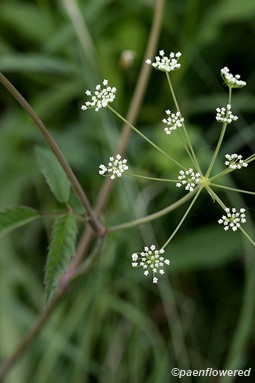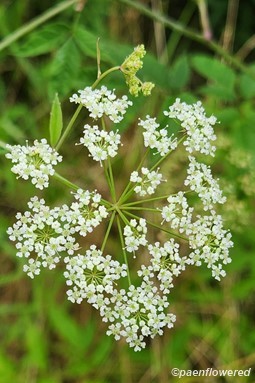Cicuta maculata
Cicuta maculata water hemlock
Add to MyPlants View Locations
This is probably the most poisonous plant in North America - do not eat any part of it. Only a small amount of this plant can cause enough disruption to the nervous system to cause severe seizures. Death can occur in 15 minutes without treatment and even small amounts of the toxin can cause severe central nervous system damage. The primary toxin is called Cicutoxin. It is most concentrated in the roots, but is present in all parts of the plant.
Water hemlock is a native short-lived perennial or biennial branched herbaceous plant, a member of the carrot family. Water hemlock is an erect plant with many branches. The toothed leaves are compound two or three times and the lance-shaped leaflets may be tinged in purple. A distinct trait is the veins of the leaves that run from the midrib to the notches between teeth, rather than to the tips of the teeth as in most plants. A sheath encloses the base of the leaf stalk. The leaves may also fold lengthwise along the mid-vein.
The main stem is green, pink, or reddish purple often streaked or spotted with purple, though the amount of pigment may vary with the plant's environment. It can grow 3-8 feet high and is found throughout temperate North America and in almost every county in Pennsylvania. The water hemlock tends to grow in moist places--wet meadows, ditches, lakeshores, and swamps and blooms from June to September.
The tiny flowers are in a flat loose cluster called an umbel that can be up to 6 inches in diameter. Each umbel is further divided into smaller umbels. Individual flowers are about 1/8 inch in diameter. They have 5 small petals. The fruit is small, angular, dry and brown and contains two seeds.
In some ways water hemlock resembles the harmless Queen Anne’s lace, but if you compare the flower clusters of water hemlock you will notice that they are less compact than Queen Anne’s lace and water hemlock does not have the single tiny purple, black or red flower in the center. The leaves of Queen Anne’s lace are also much more finely divided. Water hemlock has a root that resembles that of wild parsnip and has a similar smell. It is also possible that those foraging for the edible roots of the cattail would accidentally harvest some roots of water hemlock. Both plants grow in the same environment. The similarity of this very deadly plant to other harmless species is a warning to anyone who wants to try wild plants as food. That warning is: Know the details of your plant anatomy well. Livestock are poisoned more often than humans, because fewer people now venture into the wild food hobby.
Water hemlock resembles the non-native poison hemlock plant poison hemlock (Conium maculatum) that grows earlier in the season along roadsides and other drier areas. The poison hemlock, though, has much more finely divided leaves, resembling those of a carrot.
Habitat & Range
Grows in swamps, marshes, wet meadows, banks of steams.
Present throughout the state.
| EMP: | OBL |
|---|---|
| NCNE: | OBL |
Phenology
Flowers June through September.
Identification Tips
Veins of leaves run from the midrib to the notches between teeth, rather than to the tips of the teeth as in most plants.
Plant Codes
S-rank: S5 (Secure)
G-rank: G5 (Secure)
Cicuta maculata water hemlock
Synonyms: Cicuta maculata var. maculataAdd to MyPlants View Locations







Comments
Have you spotted this plant in your area? We'd love to hear about your experience! Share your comments or questions about the plant below. Comments are moderated before posting.